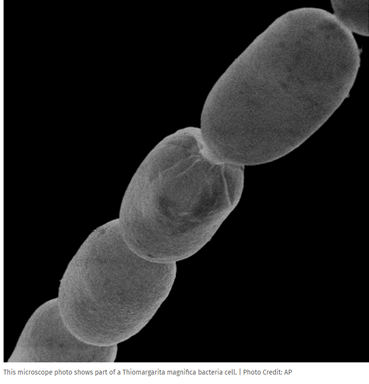

Context
Scientists have discovered the world's largest bacterium in a Caribbean mangrove swamp.
About
About the bacteria:
- The bacterium — named Thiomargarita magnifica, or "magnificent sulfur pearl" — clinging to sunken mangrove leaves in the archipelago of Guadeloupe in 2009.
- The bacterium is roughly the shape and size of an eyelash.
- The bacteria appeared as long translucent centimeter-long strings on decaying leaf matter in the water.
- Most bacteria are microscopic, but this one is so big it can be seen with the naked eye.
- The bacterium also has a complex membrane organization and a predictable life cycle.

Different from other bacteria’s:
- Bacteria are commonly thought to be “bags of enzymes,” where there is no nucleus or Golgi apparatus or any other organelles, and DNA simply floats freely through the cell.
- However, T. magnifica not only contains DNA within a membrane, but also ribosomes—which create proteins—cohabitating with the genome.
- The cell has a structure that's unusual for bacteria.
- One key difference: It has a large central compartment, or vacuole, that allows some cell functions to happen in that controlled environment instead of throughout the cell.
Guadeloupe archipelago in the French Caribbean:
- Guadeloupe, the French Caribbean tropical islands in the Lesser Antilles in the Eastern Caribbean is situated just north of Dominica and southeast of Puerto Rico.
- Caribbean mangrove swamps are packed with organic matter, with microbes in the sediment degrading this matter and producing high concentrations of sulfur.
- The sulfur-rich environment offers an energy source for bacteria like Thiomargarita magnifica.
- The researchers named its DNA-bearing organelles "pepins" after a French word for small seeds inside fruits.




